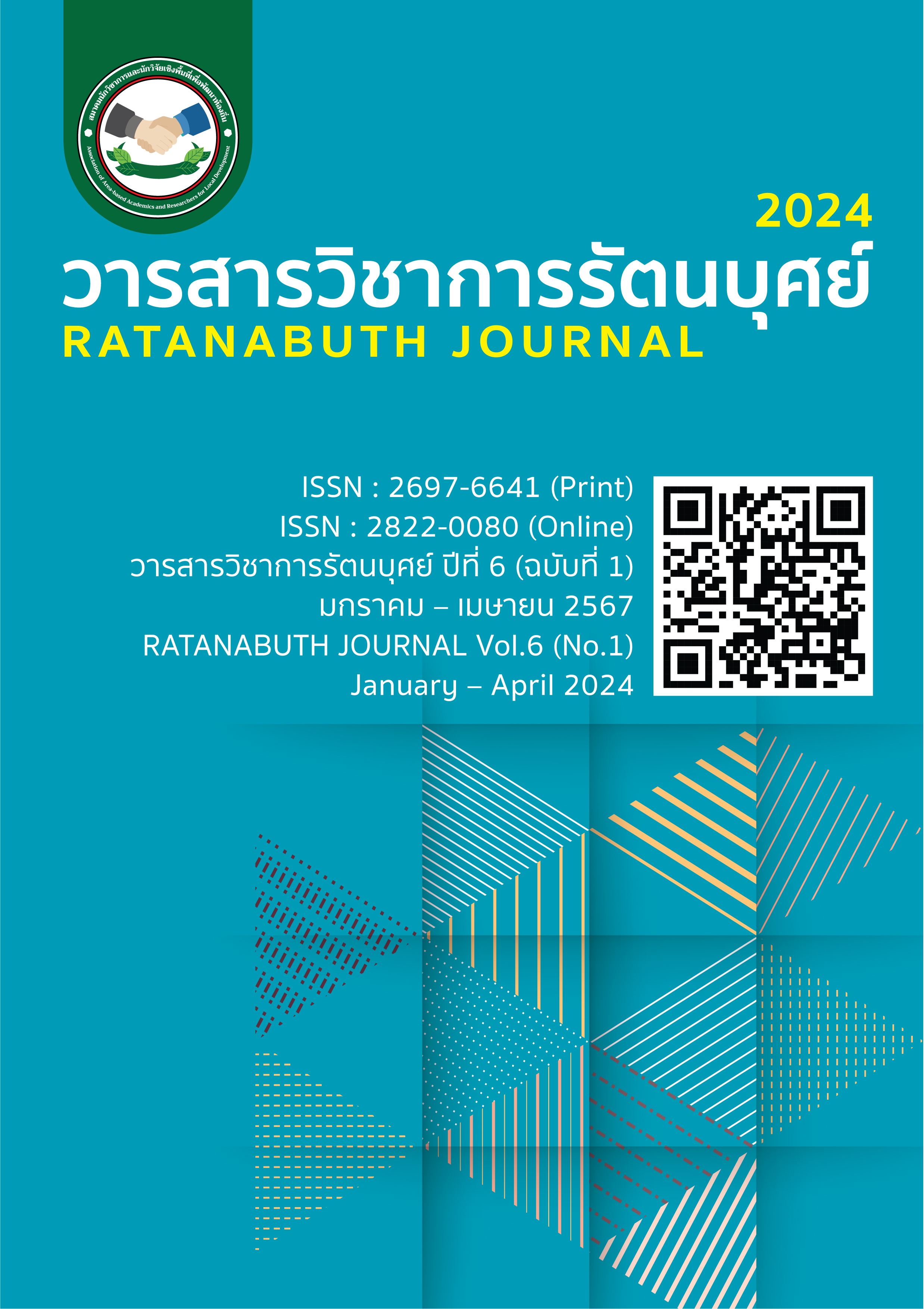Development of Competency in Active Learning Management of Teachers That Affects Student Quality at Banpamaisahakorn School Buriram Primary Educational Service Area Office 3 Development of Competency in Active Learning Management of Teachers That Affects Student Quality at Banpamaisahakorn School Buriram Primary Educational Service Area Office 3
Main Article Content
Abstract
The research aims to 1) Develop the competency in active learning management of teachers at Ban Pa Pa Mai Sahakorn School.2) Study the results of using the model for developing competency in active learning management of teachers at Ban Pa Pa Sakorn School.The sample group consisted of 27 teachers who received the development and students, which were obtained using a simple random sampling method.The tools used in the research are Structured interviews, assessments, tests, and questionnaires.Basic statistics include frequency, percentage, mean, and standard deviation. Statistics used for comparison were One Sample t-test and Two Sample t-test, t-test for Dependent, and qualitative data were analyzed using content analysis.
The results of the research found that: 1) The development of teachers' competency in active learning management was found to be1.1) Creating guidelines for developing teachers' competency in active learning management. Consists of 6 steps of operations:Step 1 Setting goals Step 2 Development planning Step 3 Development operations It consists of five steps of active learning management: 3.1) building inspiration, 3.2) learning from practice, 3.3) reflection, 3.4) discussion and conclusion, and 3.5) application of knowledge and evaluation. Step 4: Monitoring and evaluating, Step 5: Reflecting on results, and Step 6: Dissemination to all involved parties.1.2) The model for developing competency in active learning management is appropriate at a high level. and each component of the learning management competency development process is consistent with one another.2) The results of using the model for developing teachers' active learning competencies that affect student quality were found.2.1) The competency in active learning management of the teachers who received the development was at a very good level. 2.2) Grade 4 students had a higher average academic achievement score after learning than before learning. Statistically significant at the .05 level. 2.3) Grade 4 students had a higher mean score in analytical thinking ability after studying than before, with statistical significance at the .05 level.2.4) Students are satisfied with the active learning management by the teachers who received the development at a high level. The average satisfaction level is different from the average value that is the criterion value. Statistically significant at the level of .05 and higher than the criterion average. 2.5) Teachers who received the development were satisfied with the model for developing teachers' active learning competencies that affected the quality of learners. At the highest level 2.6) Participants were satisfied with the exhibition of student work. at the highest level
Article Details

This work is licensed under a Creative Commons Attribution-NonCommercial-NoDerivatives 4.0 International License.
References
กุลิสรา จิตรชญาวณิช. (2562). การจัดการเรียนรู้. กรุงเทพฯ : สำนักพิมพ์จุฬาลงกรณ์มหาวิทยาลัย.
เจษฎา จันทร์เปล่ง.(2565). การพัฒนาระบบการพัฒนาครูในการจัดการเรียนรู้ ตามแนวคิดการศึกษาแบบ 4.0 ด้วยกระบวนการชุมชนการเรียนรู้ทางวิชาชีพในโรงเรียนมัธยมศึกษา. วิทยานิพนธ์การศึกษาดุษฎีบัณฑิต สาขาวิชาหลักสูตรและการสอน: มหาวิทยาลัยมหาสารคาม.
ยุภาลัย มะลิซ้อน. (2563). การพัฒนาสมรรถนะครูด้านการจัดการเรียนรู้เชิงรุกในสถานศึกษาสังกัดสำนักงานเขตพื้นที่การศึกษาประถมศึกษามหาสารคาม เขต 2. วิทยานิพนธ์ปริญญาการศึกษามหาบัณฑิต:มหาวิทยาลัยมหาสารคาม.
ลีลาวดี ชนะมาร. (2563). การพัฒนารูปแบบการจัดการเรียนรู้เชิงรุก เพื่อส่งเสริมความสามารถในการออกแบบการจัดประสบการณ์สำหรับเด็กปฐมวัย ของนักศึกษาสาขาวิชาการศึกษาปฐมวัย. วิทยานิพนธ์ปรัชญาดุษฎีบัณฑิต,ชลบุรี: มหาวิทยาลัยบูรพา.
วรัชยา ประจำ. (2563). รูปแบบการพัฒนาครูโดยใช้ชุมชนการเรียนรู้ทางวิชาชีพเพื่อส่งเสริม การจัดการเรียนรู้เชิงรุก โรงเรียนอนุบาลห้วยทับทัน.สำนักงานเขตพื้นที่การศึกษาประถมศึกษาศรีสะเกษ เขต 2 สำนักงานคณะกรรมการการศึกษาขั้นพื้นฐาน กระทรวงศึกษาธิการ
วศินี รุ่งเรือง. (2562). รูปแบบการพัฒนาครูโดยใช้การพัฒนาบทเรียนร่วมกันผ่านชุมชนแห่งการเรียนรู้เชิงวิชาชีพที่ส่งเสริมศิลปะการสอนของครู. วิทยานิพนธ์ปริญญาการศึกษาดุษฎีบัณฑิต สาขาวิชาหลักสูตรและการสอน, พิษณุโลก: มหาวิทยาลัยนเรศวร.
วิริยะ วรายุ และอนุชา กอนพ่วง. (2560). การพัฒนาชุมชนการเรียนรู้ทางวิชาชีพของโรงเรียนบ้านดอนมูล (สุวรรณสาราษฎร์บำรุง) โดยการเทียบเคียงสมรรถนะกับโรงเรียนลำปลายมาศพัฒนา. วิทยานิพนธ์การศึกษาดุษฎีบัณฑิต, พิษณุโลก: มหาวิทยาลัยนเรศวร.
สมพิศ สุขกัลยา. (2564). การพัฒนาโปรแกรมพัฒนาครูด้านการจัดการเรียนรู้โดยใช้ปัญหาเป็นฐานสำหรับสถานศึกษา สังกัดสำนักงานเขตพื้นที่การศึกษามัธยมศึกษา เขต 28. วิทยานิพนธ์การศึกษามหาบัณฑิต สาขาวิชาการบริหารและพัฒนาการศึกษา: มหาวิทยาลัยมหาสารคาม.
สำนักงานคณะกรรมการการศึกษาขั้นพื้นฐาน. (2562). หลักสูตรฝกอบรมการนิเทศการจัดการเรียนรูเชิงรุก (Active Learning) โดยกระบวนการ Coaching & Mentoring. กรุงเทพฯ : โรงพิมพชุมนุมสหกรณการเกษตร แหงประเทศไทย จํากัด.
สำนักงานเลขาสภาการศึกษา (2561). สภาวะการศึกษาไทยปี 2559/2560 แนวทางการปฏิรูปการศึกษาไทยเพื่อก้าวสู่ยุค Thailand 4.0. กรุงเทพฯ : สำนักงานเลขาธิการสภาการศึกษา
สำนักนายกรัฐมนตรี. สำนักงานคณะกรรมการการศึกษาแห่งชาติ.(2545). การประเมินผลการเรียนรู้ที่เน้นผู้เรียนเป็นสำคัญ : แนวคิดและวิธีการ. พิมพ์ครั้งที่ 2. กรุงเทพฯ: วัฒนาพานิช.
อนุสสรา เฉลิมศรี. (2563). การพัฒนาความสามารถในการจัดการเรียนรู้เชิงรุกของครูประถมศึกษาด้วยกระบวนการชุมชนแห่งการเรียนรู้ทางวิชาชีพ. ปริญญานิพนธ์. กรุงเทพฯ: มหาวิทยาลัยศรีนครินทรวิโรฒ.
อาชัญญา รัตนอุบลและคณะ. (2559). รูปแบบการส่งเสริมการเรียนรู้ตามอัธยาศัยของผู้สูงอายุในสังคมเมือง.กรุงเทพมหานคร: โรงพิมพ์แห่งจุฬาลงกรณ์มหาวิทยาลัย.
Akinoglu, O., & Tandogan, O. R. (2007). The effects of problem-based active learning in science education on students’ academic achievement, attitude and concept learning. Eurasia Journal of Mathematics, Science & Technology Education, 3, 71-81.
Aydede, M.N., & Matyar, F. (2009). The effect of active learning approach in science teaching on cognitive level of student achievement. Journal of Turkish Science Education, 6(1), 115-127.
Bishop, L.J. (1979). Staff development and instructional improvement plan and procedures. Boston: Allyn and Bacon.
Bonwell, C. C.; & Eison, J. A. (1991). Active Learning: Creating Excitement in the Classroom. ERIC Digest. Washington D.C.: ERIC Clearinghouse on Higher Education.
Bray M. (2003). Adverse Effects of Supplementary Private Tutoring: Dimensions, Implications, and Government Responses. publisher: ‘Ethics and Corruption in Education’. Paris: UNESCO International Institute for Educational Planning
Castetter, W.B. (1996). The personnel function in education administration. New York: Macmillan.
Gordon, S.E. (1993). We Do: Therefore, We Learn. Training & Development. Vol. 47, no.10.
Jeder. (2014). Training Teachers’ Ethical Skills in License and Master Programs. Procedia - Social and Behavioral Sciences. 142 (2014) 691 – 694
Shenker, J. I., Goss, S. A., & Bernstein, D. A. (1996). Instructor’s Resource Manual for Psychology: Implementing Active Learning in the Classroom. Boston: Allyn & Bacon.
Thompson, S. C., Gregg, L., & Niska, J. M. (2004). Professional learning communities, leadership, and student learning. Research in Middle Level Education. Online, 28(1), 1-13.


